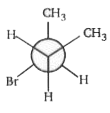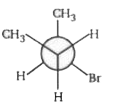Elimination of bromine from 2-bromobutane results in the formation of
(i)equimolar mixture of 1 and 2-butane
(ii)predominantly2-butene
(iii)predominantly 1-butene
(iv)predominantly 2-butyne.
equimolar mixture of 1 and 2 butene
predominantly 1-butene
predominantly 1-butene
predominantly 2-butyne
The correct Answer is:B
To solve the question regarding the elimination of bromine from 2-bromobutane, we can follow these steps:
Step 1: Identify the Structure of 2-Bromobutane
2-bromobutane is a four-carbon alkane with a bromine atom attached to the second carbon. The structure can be represented as follows:
CH3−CH(Br)−CH2−CH3
Step 2: Understand the Elimination Reaction
In an elimination reaction, a small group (in this case, bromine) is removed from a larger molecule, leading to the formation of a double bond. The reaction typically involves the removal of a hydrogen atom from a beta carbon and the halogen from the alpha carbon.
Step 3: Identify Alpha and Beta Carbons
In 2-bromobutane:
- The alpha carbon is the one attached to the bromine (C2).
- The beta carbons are the carbons adjacent to the alpha carbon (C1 and C3).
Step 4: Use a Strong Base for Elimination
When treated with a strong base like alcoholic KOH, the base will abstract a hydrogen atom from one of the beta carbons, leading to the formation of an alkene.
Step 5: Determine Possible Products
1. If H is removed from C1 (beta carbon):
- The product formed will be 1-butene:
CH2=CH−CH2−CH3(1−bute≠)
2. If H is removed from C3 (beta carbon):
- The product formed will be 2-butene:
CH3−CH=CH−CH3(2−bute≠)
Step 6: Apply Zaitsev's Rule
According to Zaitsev's rule, the more substituted alkene is favored in elimination reactions. In this case:
- 1-butene has one substituent (the double bond is at the end).
- 2-butene has more substituents (the double bond is in the middle and is more stable).
Step 7: Conclusion
Since 2-butene is more substituted and therefore more stable than 1-butene, the predominant product of the elimination of bromine from 2-bromobutane will be predominantly 2-butene.
Final Answer
The correct option is (ii) predominantly 2-butene.
---
2-bromobutane is a four-carbon alkane with a bromine atom attached to the second carbon. The structure can be represented as follows:
In an elimination reaction, a small group (in this case, bromine) is removed from a larger molecule, leading to the formation of a double bond. The reaction typically involves the removal of a hydrogen atom from a beta carbon and the halogen from the alpha carbon.
In 2-bromobutane:
- The alpha carbon is the one attached to the bromine (C2).
- The beta carbons are the carbons adjacent to the alpha carbon (C1 and C3).
When treated with a strong base like alcoholic KOH, the base will abstract a hydrogen atom from one of the beta carbons, leading to the formation of an alkene.
1. If H is removed from C1 (beta carbon):
- The product formed will be 1-butene:
CH2=CH−CH2−CH3(1−bute≠)
- The product formed will be 2-butene:
CH3−CH=CH−CH3(2−bute≠)
According to Zaitsev's rule, the more substituted alkene is favored in elimination reactions. In this case:
- 1-butene has one substituent (the double bond is at the end).
- 2-butene has more substituents (the double bond is in the middle and is more stable).
Since 2-butene is more substituted and therefore more stable than 1-butene, the predominant product of the elimination of bromine from 2-bromobutane will be predominantly 2-butene.
The correct option is (ii) predominantly 2-butene.
Topper's Solved these Questions
- HALOALKANES AND HALOARENESBOOK - NCERT FINGERTPS ENGLISHCHAPTER - HALOALKANES AND HALOARENESEXERCISE - Higher order thinking skills
8 Videos
- HALOALKANES AND HALOARENESBOOK - NCERT FINGERTPS ENGLISHCHAPTER - HALOALKANES AND HALOARENESEXERCISE - Exemplar problems
24 Videos
- HALOALKANES AND HALOARENESBOOK - NCERT FINGERTPS ENGLISHCHAPTER - HALOALKANES AND HALOARENESEXERCISE - Physical properties
7 Videos
- GENERAL PRINCIPLES AND PROCESSES OF ISOLATION OF ELEMENTSBOOK - NCERT FINGERTPS ENGLISHCHAPTER - GENERAL PRINCIPLES AND PROCESSES OF ISOLATION OF ELEMENTSEXERCISE - Assertion And Reason
15 Videos
- POLYMERS BOOK - NCERT FINGERTPS ENGLISHCHAPTER - POLYMERS EXERCISE - NCERT Exemplar
9 Videos
Similar Questions
Knowledge Check
In the dehydrohalogenation of2-bromobutane, which conformation leads to the formation ofcis-2-butene ?
A B
B C
C D
D
The reaction of toluene with CI2 in presence of FeCI3 gives predominantly
View SolutionThe formation of 1,2-dibromoethane from ethene and bromine is an example of :
View SolutionAssertion:2-Bromobutane on reaction with sodium ethoxide in ethanol gives 1-butene as a major product
Reason:1-butene is more stable than 2-butene.
View SolutionConversion of 2-Butene into n-Butane
View SolutionThe number of stereoisomers obtained by bromination of trans-2-butene is :
View SolutionWhat type of isomerism is shown by 1-butene and 2-butene?
View SolutionArrange the melting points of following compounds in decreasing order
1. n - butane
2. cis - 2- butene
3. trans -2- butene
4. 1 - butyne
View Solution
